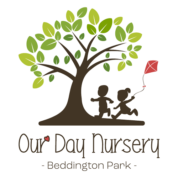Our Day Nursery follows the Early Years Foundation Stage (statutory guidance implemented throughout the setting) and Development Matters, which is non-statutory curriculum guidance to support.
- The best for every child
- High-quality care
- The curriculum – what we want the children to learn
- Pedagogy - the theory for teaching children
- Assessment: checking what children have learnt
- Self-regulation and executive function
- Partnership with parents
- Playing and Exploring
- Active Learning
- Creating and Thinking Critically
- Communication and Language development
- Personal, Social and Emotional Development
- Physical Development
- Literacy
- Mathematics
- Understanding the World
- Expressive Arts and Design
In addition to the above specific requirements for the operation of Our Day Nursery, we also feel it is important to encourage participation from parents and carers. Therefore, representatives are chosen from each room to form our Parent Nursery Association. Each room also has a mascot, which is taken home weekly by one of the nursery children, allowing them to communicate the adventures of the mascot each week in our mascot diary, supporting parent partnership.
